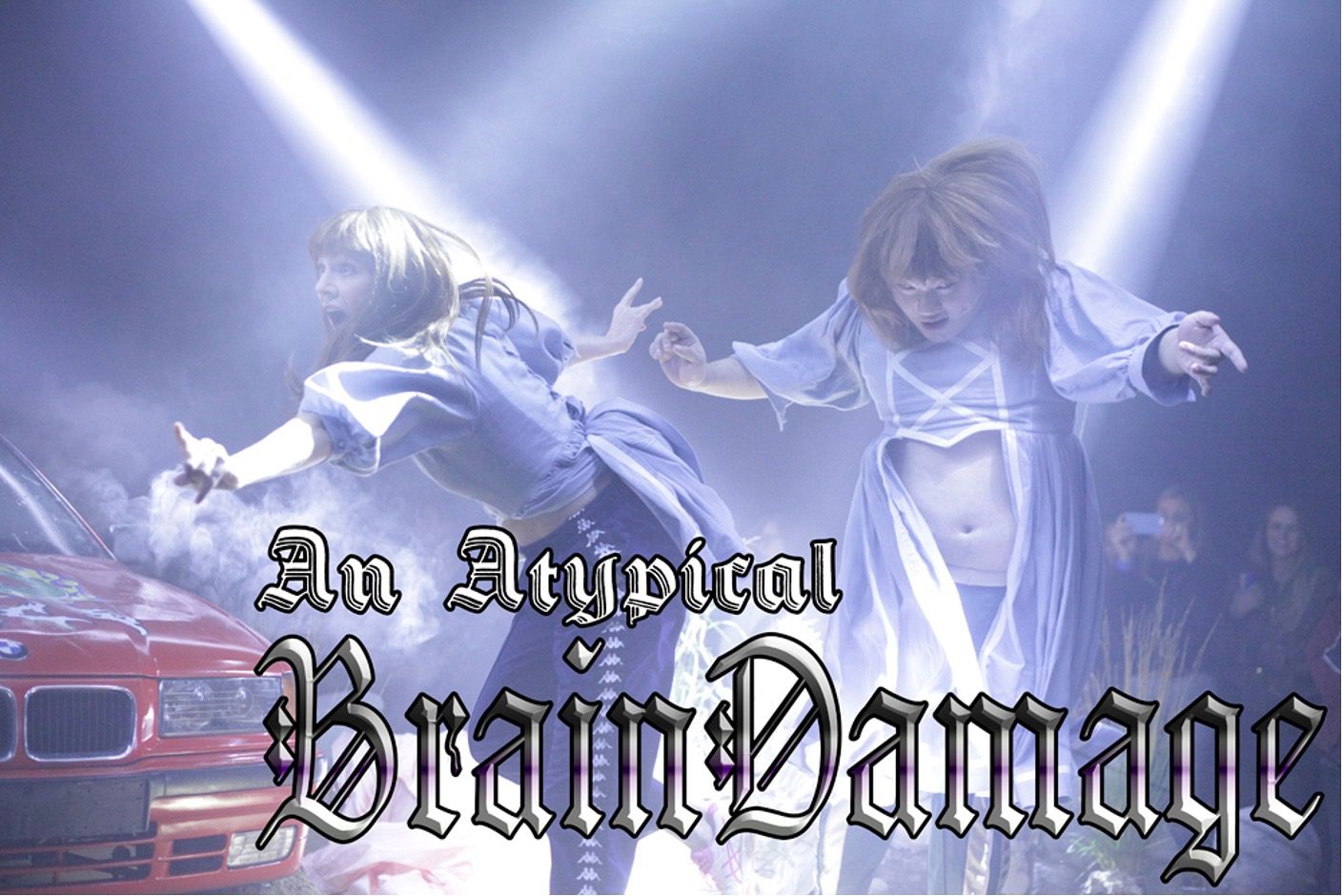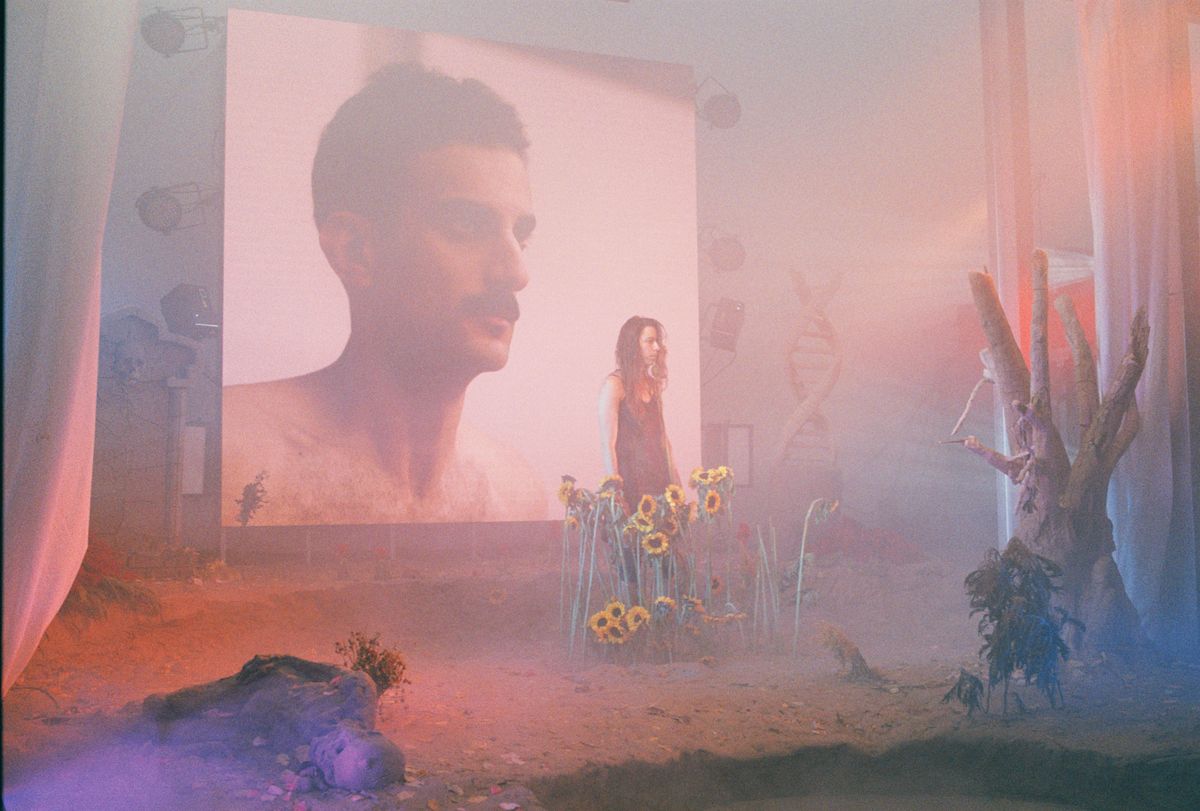§peculative £abulation a.k.a §.£, may also stand for science fiction, science fact, speculative feminism, soin de ficelle... §.£. as storytelling and fact telling, the patterning of possible worlds and possible times, material-semiotic worlds, gone, here, and yet to come.
— Donna J. Haraway, Tentacular Thinking: Anthropocene, Capitalocene, Chthulucene.
Doors open. Purple clouds burst forth from the metallic gate. They cannot wait to get out — for the encounter of curious, meandering minds, and the chemical reactions with the incoming symbiotic molecules. As if they have waited a million years for this moment.
You are queueing, showing the ticket to the doorman while being told to store your big heavy backpack in the cloakroom. A glimpse of the mysterious purple light escaping from the unknown space fascinates you, but you have to head the opposite direction to remain part of the institutional discourse — a shout from (the socially constructed) reality slows you down. However, you cannot help but turn around for another glimpse. You hear the beats before the music. You hear the music before your (own performative) entrance.
Seeming to come from underground, the beats grow, expand, envelop you while you explore the space. Through the purple smoke, you discover the peculiar figures that are scattered around: sitting, washing, sewing, awakening, coming back to life… There is neither a seat nor a single distinct stage prepared for you. What’s left is only the space in-between: a space in constant flux, unidentifiable; a string space that connects you and the figures you see through the purple smoke when your “role” as a “passive spectator” was not even given as an option. Then after a while, when one of the figures lying on the bar table — the “drag Cheshire cat,” known as the evil wife (played by baby ChinaYu) later in the performance — looks straight into your eyes with a seductive, sleepy wink, thinking, observing, then offering you a glass of Bier vom Fass, you may, perhaps, start to wonder, am I becoming one of them… An invitation, specifically addressed to you, “to become one of them” is the secret code to enter the dithyrambic SF of Chen Tianzhuo.
This is a glimpse of An Atypical Brain Damage’s German premiere in Munich on October 28, 2017, the second “performative happening” from Chen after the creation of Ishavara (2016), where his intuitive demand for a speculative, psychedelic, and (trans-)sensational assemblage of aesthetic experience first emerged. Such yearning then developed into an exploratory process of “becoming” that Chen “fabulates,” interweaving possible worlds, times, and creatures that are “gone, here, and yet to come.” This fluid in-betweenness contributes to the lavish complexities that orbit around Chen’s works, swooshing them out of pre-established definitions, orders, and boundaries. To claim that Chen Tianzhuo is one of the (so-called) “post-internet artists” according to his undefinability is thus nothing more than a capitalized, oversimplified (post-internet) hashtag: #EnfantTerriblederChinesischenKunst, #popopera, #JapaneseButoh, #LondonRaveScene, #psychosexual, #easternwestern, #clubbing, #instagramming, #eyeful, #cult, #blablabla…We are living in a time when so-called universality is denounced, gradually replaced by an individual evaluation system, yet the “individual,” on the other hand, tends to become more and more homogeneous as the globe diminishes along with an expansion of globalization. Within this process, where the sense of one’s being is reduced into hashtags, GIFs, and emojis, identification becomes something tricky. This collective blindness allows one to easily fall into the trap of grouping, categorizing, labeling, or reproducing stereotypes (driven by the efficiency of such a process). This is a manifestation of perceiving while forgetting to look at things anew — we are already haunted by the “post-.” By reconsidering the “post-” and deleting all of the (so-called post-internet) hashtags, perhaps one would be able to discover something nostalgic, novel, yet classically romantic within the realm of our fragmented contemporary in Chen Tianzhuo’s work, that is, the “transgression” of corporeality (a.k.a eroticism), and the “flow” of consilience.
Corporeality is the aura in all of the “performative happenings” created by Chen Tianzhuo, bringing his ecstatic visionary from abstractions into organisms. Through an embodiment of the senses and mobilizing such embodiment in between “be-ing” and “being-toward,” the reality of the “performative happenings” reinforces itself by the “corpus”: alive, dead, neither alive nor dead, naked, without disguise. Chen catalyzes this process through transgression, defined by Pasi Falk in his book The Consuming Body as “the crossing of borders, points to the dynamics in which the order of the secular and everyday world is shattered,”1asi Falk, The Consuming Body (London: Sage Publications 1994). and thus becomes “erotic.” Eroticism is not just about the consumption of sexuality and (so-to-speak socially defined) restraints in general; it is the continuity of “being” as emphasized by the dynamics of transgression itself — recognising and crossing the borders. Back to its origin, Georges Bataille believes that eroticism is not only about “physical and emotional” being, but it also attaches to the religious and mystical world of experience.2Georges Bataille, tran. Mary Dalwood, Eroticism, Death and Sensuality (San Francisco: City Lights Books 1962),15,23. All these forms of eroticism display one’s fundamental striving towards a “continuity of being,” the ultimate form of death: “Eroticism … is assenting to life up to the point of death.”3Ibid, 11. The flow of eroticism in Chen’s work develops organically to a level that becomes biomorphic, opening bodies to the unknown. When looking at his previous performative happening Ishvara, curator and art critic Bowen Li comments, “It recalls one of the most ancient effects of the theatre: in an act that is summoning and entrancing, the unseen, hidden, forbidden is staged, brought alive to those who, before the critical, theatrical event, believe only half-heartedly.”4See Bowen Li, Chen Tianzhuo and Ishavara: Smart or Sincere, 2. 08. 2016, link. Eroticism is the ritual Chen’s performative bodies generate when depicting the unseen, the hidden, and the forbidden; it reveals the limits of anthropocentric culture and crosses these limits, simultaneously transposing it back to its spiritual and mythical Gaian origin. In Ishvara, decorated naked bodies are washed by streams of consecrated lights that illuminate their imaginary holiness. Within the displaced montage of religion and spirituality, nakedness becomes a form of dress (to borrow John Berger’s words), and eroticism becomes the cult of the divine. In An Atypical Brain Damage, the cult transgresses to the mystical world: while the judge gives the final sentence to the wife, the wild bird (which emerged from a previously undefinable body) slowly creeps onto the stairs and leans against his feet. The wild bird unzips the judge’s trousers, takes out his private parts, and caresses his sex organ with its long sharp beak. Eroticism now is displayed in a mystical sequence of absurd and almost brutal sexual acts. It is a bizarre combination of animalistic affection and ritualistic fetish, transgressing into a meticulous carnal loophole where absolute uncertainties flow — whether they are human, inhuman, posthuman, post-inhuman, animal, nonanimal… Whatever they might be or become, the limits disappear. As such, eroticism is embroidered into corporeality with the particular emotional and physiological resonance it produces. It encapsulates liveness and romanticism into the alien bodies Chen Tianzhuo created, decolonizes their identities, and ultimately free these bodies from the pre-established “manmade” sociocultural condition.
In a conversation on bodies and performance entitled “Reflecting (on) conceptuality,”5“Reflecting (on) conceptuality,” InterAkta issue 4, 33-34. artist Jan Fabre brought up the idea of consilience, which literally means “where things hook up together from different disciplines based on a theory of facts.” It was first developed by scientist William Wedwell for inductive science. By means of consilience, artists such as Fabre and Jan Lauwers are “trying to find a language that connects different disciplines.”6Ibid. Again, through transgression, consilience can be considered as the unity of knowledge and experience that emerged from chaos, a kaleidoscopic totality of variations within which the boundaries of disciplines and orientations are melted. As a result, things may not seem how they are supposed to be and thus resulting in the difficulty of identification. This is perhaps how one experiences Chen Tianzhuo’s performative happenings, as an erratic contingency of déjà vu that is rather “foreign”: she looks like a lady, but he is not; it looks like a dog but he is not; he looks like a cyborg but she is not; it looks like a subtitle but it is not… Nothing can be reduced into an absolute definition when Chen crafts every single entity into his world of aesthetics. There is no male or female, human or animal, hetero or homo… And most certainly not the most cliché simplification of Eastern or Western. Consilience grows along with the oscillation of the binaries. Identification is stretched into spectrums. It flows and floats in the process of constant transition of becoming. Nothing repeats itself, nothing ever comes back, except coming itself, which is never the same — but, rather, the indefinitely altered return of the same. This is, indeed, chaotic as Chen’s realm of aesthetic consists in channeling an absent cosmos out of playful contempt for the events of the world (and therefore it becomes political), regardless of all of those socially constructed signifiers which are already half-dead even before the meaning arrives.
The chemical reaction between corporeality and consilience may then lead to a rhizomatic constellation of assemblage, defined by Deleuze as
…a multiplicity which is made up of many heterogeneous terms and which establishes liaisons, relations between them, across ages, sexes and reigns – different natures.
Thus, the assemblage’s only unity is that of a co-functioning: it is a symbiosis, a “sympathy”. It is never filiations which are important, but alliances, alloys; these are not secessions, lines of descent, but contagions, epidemics, the wind.7Gilles Deleuze, Clair Parnet, Dialogues II, p. 69.
Assemblage’s multiplicity allows a decentralized, nonhierarchical, subjectless cosmo(s)-politan (that is independent of any recapitulation that maybe made of it in a scientific or theoretical corpus)8Gilles Deleuze, Felix Guattari, A Thousand Plateaus, tr. Brain Massumi (Minneapolis: University of Minnesota Press, 1987), 22-23. come into being as a symbiotic body that constantly flows and fluctuates within absolute uncertainties. In this light, the making of Trance Demo (2019) is inevitable in the process of Chen Tianzhuo’s essential becoming, both artistically and critically self-exploratory. Synthesizing Ishavara, An Atypical Brain Damage, and Chen’s other works from 2014 to present, the 12 hour-long performative happening can be considered an assemblage of homo without sapiens, aliens without identities, an incipient light of echoes, speed gurus, childlike wonders, purple tears, candy flip, elusive beats, laser fables, spiritual ninjas, ossified romance, cosmic inferno, simulating machines, failed amphibians, sedated ghosts, rainbow monsters, drunk sunflowers, stoned stones, mesmerized ears, crispy meteor eyes, cutting-edge pilgrims, oscillation among the clouds, metafictional anxieties, neon babies tripping at the picnic, electrified spirits dancing in city blues, sublunary creatures licking the orchids, chasing the dragon as the sun went down … featuring all of Chen’s haptic, vibrant, spooky, tentacular, lavish noumena, “limboing” to the Ӏìʍҍօ ҽղçհąղէҽժ (a.k.a Trance: Tianzhuo Chen Solo Exhibition), a seemingly dreamy hyper-dimension architected and automated within Chen’s own solo creations: an (っ◔◡◔)っටէհҽɾ చօɾӀժ par excellence worlding within the process of its own eternal (re)making. This Ӏìʍҍօ ҽղçհąղէҽժ remarkably alter a return to the inner multiplicity of the body, time, and space, transforming the so-called exhibition hall into a symbiotic organism that allows Chen’s ecstatic assemblage to take place. In addition, every 12 hours triggers a transference shift along with the temporal and spatial frequency of the performative happening. Each individual (audience, performer, nonhuman, human, etc.) in Trance may experience different levels of transience as her/his/their/its own psychological embodiment while the body traverses through space, interlacing with other bodies, playing with various touches, observing scents, hearing colors, sensing noises… Flowing in the stretched Trance reality, these critical beings with (or without) their decolonized identities then reach a psychedelic transcendental state, experiencing a meticulous slowness within the speed of light. Within such slowness, these trembling bodies are prolonged, expanded, electrified, meditated, deformed, rendered, then reactivated by the prehistorical memories stored in their biological cells, coming once again into the multiplicity of their beings.
“I’m dead because I’m stupid. My body survives because I cannot find a way out. The human race is becoming an army of sleepwalkers: people suffering from Alzheimer’s disease, people taking pills to face reality, smiling, saying yes, yes…” Philip K. Dick reflects through the character of Pris in Do Androids Dream of Electric Sheep?. Published in 1968 during the Vietnam war, this novel conveys Dick’s pessimistic point of view of an imaginary future and has evolved to become a curse on our contemporary reality as we both witness and experience the “sickness of human race” on nearly a daily basis. Not to mention the current ongoing global pandemic, we live at a turning point when daily life is rife with agitation, opposition, and anxieties; a time when drugs become the antidote. In this way (no matter how politically inconsequential it might seem to be), as his speculative fabulation in response to the world he lives in, Chen Tianzhuo’s Ishavara, An Atypical Brain Damage, and Trance ultimately turn into an apocalyptic metaphor of our existential time, a time when Paul Klee’s Angelus Novus, responding to the widespread destruction of colonialism, industrialization, communist revolutions, and capitalist wars, is eventually “propelled (hunted) by ‘the storm we call (post-)progress,’”9Walter Benjamin, Theses on the Philosophy of History, Illumina8on (New York: Schocken Books 1968), ed. Hannah Arendt, trans. Harry Zohn, 253 - 164. per Walter Benjamin.
So that they conjured their own kingdom of forgetfulness, the unknown, the Acid Club, the Picnic, the Ksana, the moment of 19:53, to be the Paradise Now, announcing that Our Future is Bright while Drawing of the Dead — they choose to dance, with themselves, with me, with you, with the other, as an antagonistic epiphany of passé humanity, and as the celebration of the future’s obscure uncertainties. When the music drops deeper, light strobes harder, everything synchronizes with the beat of our pumping hearts and it dilates our pupils, the complexity of intellectual interpretation is then withdrawn into the simple ways of seeing: direct, straight to the point. Bodily abstractions of the present beings, no matter if they are biomorphic alien bodies or you, me, the DJ, or Chen Tianzhuo himself, are condensed into emotional tonalities, creating the intensity within experience, a necessary moment in the process of fashioning divine madness into the objective truth (or not), which, we call Beauty.
Therefore we must forget, on our way to the cloakroom before entering the metal gates, the club, the gallery, the exhibition hall, the elsewhere and nowhere, tentatively, incidentally, the hashtags that have invaded our minds from the socially constructed reality, remediated, even before we see them coming; we must forgo the hidden, sealed, concealed, signed, squeezed, compressed, repressed (pre-)interpretation and (post-)inquisition. Then, perhaps, a new cosmos may form from a simple incident of “when our eyes touch…”10Jacques Derrida, On Touching—Jean-Luc Nancy (California: Stanford University Press 2005) trans. There will be the light, to light before the light of the day, to light the unknown, to light the pandemic world — “Quand nos yeux se touchent, fait-il jour ou fait-il nuit?”
We might then become octopi, swinging to Neptune.
How romantic it would be.
*This article is part of the writer’s current on-going doctoral research entitled Being Human is Vintage - monsters, cyborgs, bacteria, octopus … towards a Posthuman Performativity. This book will be published in 2022.
oxi pëng is a symbiotic being who writes (sci-fi academic papers), creates (posthuman-performances), and dreams (of pink tardigrades) softly.







